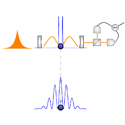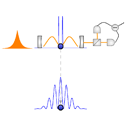In two places at once
A fundamental feature of quantum physics is superposition of states, such as the double slit experiment in which a particle passes through both slits at the same time to interfere downstream. This kind of spatially separated quantum superposition has been observed for particles from electrons to complex molecules, but what about larger macroscopic systems?
The biggest obstacle is decoherence—preparing and measuring a superposition of so many atoms requires minimizing environmental interactions that would otherwise rapidly destroy this fragile state. Writing in Physical Review Letters, Oriol Romero-Isart from the Max Planck Institute for Quantum Optics in Garching, Germany, and colleagues propose a method for creating and observing quantum superpositions of objects with millions of atoms.
Romero-Isart et al. consider the case of a nanometer-size dielectric sphere, trapped and cooled in an optical cavity, which prepares an initially pure quantum state of the center of mass. The sphere can then be released from the first trap to enter a second cavity, in which a carefully designed laser pulse creates a superposition of the two distinct spatial positions (similar to a double slit). As the superposition evolves in time, measurement of the particle’s center of mass reveals the interference pattern of the two wave functions centered at different locations. The authors note that the achievement of a large superposition of such massive objects should enable more stringent tests of quantum mechanics, especially of theories predicting a spontaneous collapse of the wave function. – David Voss





